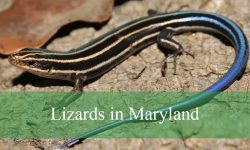A variety of moth and butterfly species can be found in North Carolina as caterpillars. Some of the state’s caterpillars are dangerous, producing allergic reactions or skin irritations even as they change into stunning winged animals. It is imperative to acknowledge and honor these residents as well as any potential risks. This post will discuss 26 different caterpillar species that can be found in North Carolina, some of which are poisonous.
Different Types of Caterpillars in NC
Cloudless Sulphur Caterpillar (Phoebis sennae)
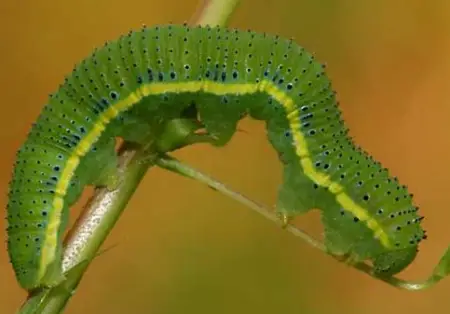
The wings of the Phoebis sennae butterfly, also referred to as the Cloudless Sulphur Caterpillar, are oddly angled. When the caterpillars hatch, their backs are speckled with black dots, and they have yellow or green colors with stripes along the sides.
They consume leaves and blossoms, particularly those that are in the Senna and Cassia families. These plants contain poisons that the caterpillars eat, turning them dangerous and repellent to would-be predators.
Red-Spotted Admiral Caterpillar (Limenitis arthemis)
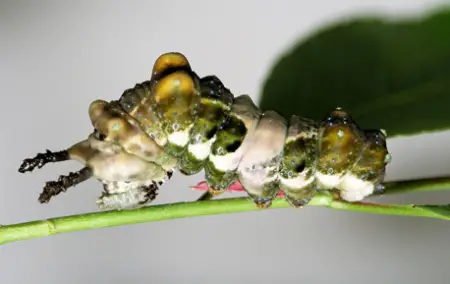
The Red-Spotted Admiral Caterpillar (Limenitis arthemis) is a species that resembles bird droppings throughout its growth phases. It has two distinct thoracic horns and a color spectrum of green to brown with creamy patterns. Instead of spikes, look for rounded projections around its head to help identify it from the viceroy caterpillar.
Originally from North America, they primarily consume the leaves of willow, poplar, and aspen trees, while some also like the leaves of yellow birch and black cherry trees. This caterpillar, despite its peculiar appearance, is benign and poses no threat to humans.
Luna Moth Caterpillar (Actias luna)
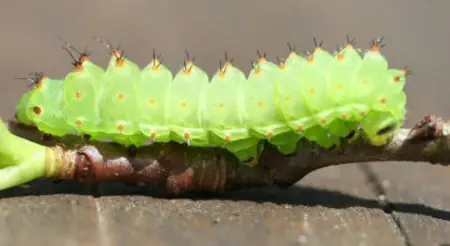
Actias luna, the Luna Moth Caterpillar, is also known as the American moon moth or a large type of silk moth, with a maximum length of 4 inches. Its natural green tint fades to areas of magenta and yellow as it ages.
Because of their striking colors, the moths, which mostly devour the leaves of walnut, hickory, and pecan trees, may seem menacing to people, although neither them nor their caterpillars are dangerous.
Common Buckeye Caterpillar (Junonia coenia)

The 1.5-inch Common Buckeye Caterpillar, also known as Junonia coenia, thrives in open spaces with minimal vegetation. Bright patterns of beige, gray, and white cover their black bodies. The sides are adorned with orange dots and white streaks.
Unlike many others, buckeye caterpillars like to be alone themselves. They primarily eat snapdragon, toadflax, and other native weeds, as well as weed plantains and vibrant-flowered Gerardia. Despite having spines, they pose little threat to humans.
Gulf Fritillary Caterpillar (Dione vanillae)
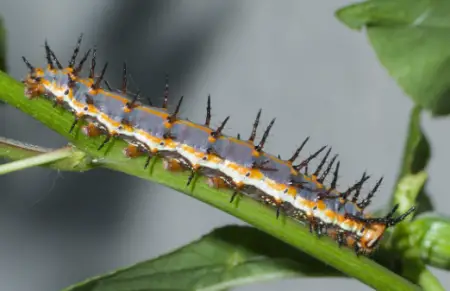
Growing into an eye-catching orange butterfly with extended wings, the Gulf Fritillary Caterpillar (Dione vanillae) is often associated with the passion butterfly family. The transparent caterpillar inside hatches from bright yellow eggs. The caterpillar has bright orange hue and black prickles when it is fully developed.
Their main food source is the passionflower, especially the purple varieties. The toxic larvae and repulsion of the mature Gulf fritillary butterfly dissuade birds.
Army Cutworm Caterpillar (Euxoa auxiliaris)
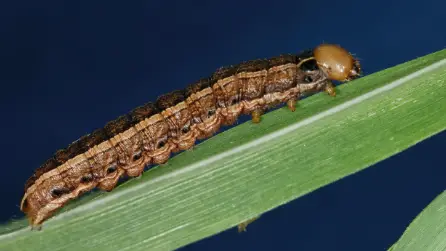
The Army Cutworm Caterpillars (Euxoa auxiliaris) build mesh-like shelters out of the turf to conceal themselves during the day. When fully grown, they are about 1½ and 2 inches long and have colors varying from green to black. They have two distinct stripes on each side, one orange and the other dark, and darker top sides. They eat a variety of foods, including grasses, wild plants, and crops, and they pose no threat to humans.
Giant Leopard Moth Caterpillar (Hypercompe scribonia)

Grown Giant Leopard Moth Caterpillars are characterized by strong black hairs that emerge from brownish nodules, and they are a striking black color with red spaces between segments. They gorge on leaves from all kinds of plants, such as citrus, violets, dandelions, and honeysuckle. Though they appear menacing, they are entirely benign.
Stinging Rose Caterpillar (Parasa indetermina)
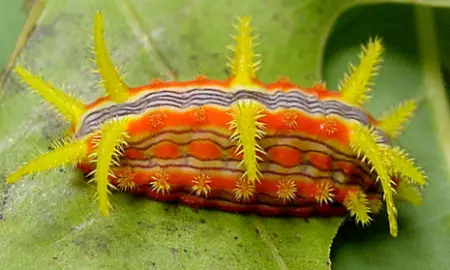
The striking orange, purple, red, and yellow hues of Parasa indetermina, sometimes known as the Stinging Rose Caterpillar, give it an almost artistic appearance. It typically consumes the leaves of trees like dogwood, hickory, and apple. It is distinguished by its seven pairs of horn-like spines, each of which contains a bothersome substance. The spine may shatter and sting severely if a substance comes into unintentional contact with human flesh.
Spun Glass Slug Caterpillar (Isochaetes beutenmuelleri)
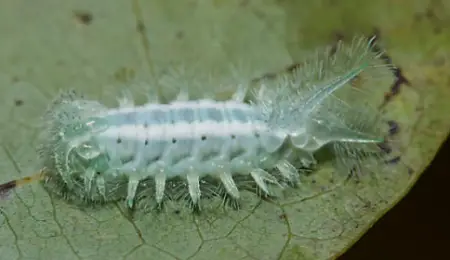
The Spun Glass Slug Caterpillar (Isochaetes beutenmuelleri) is a translucent, needle-like caterpillar that looks like delicate spun glass in its larval state. Swamp oak trees are its main food source. Use cautious when handling this caterpillar as its venomous spiky hairs can cause skin irritation when touched.
Tiger Moth Caterpillar (Arctia caja)
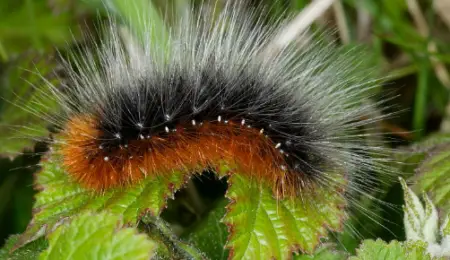
The Tiger Moth Caterpillar (Arctia caja) is distinguished by its enormous black body and dense layer of black and ginger hairs. In addition to a range of wild plants and greens, adult moths only eat the nectar of flowers. These caterpillars contain potent poisons that can induce nausea, severe stomach problems, and in extreme cases, even death, therefore it is best to proceed with caution. They are sometimes employed in agriculture to control pests due to their toxicity.
White Furucla Moth Caterpillar (Furcula borealis)

The White Furcula Moth Caterpillar (Furcula borealis), with its distinctive hair tuft situated between its head and upper torso, is easily recognized. It is primarily active at night. Its body is either yellow or green with a dark brown diamond-shaped mark in the center that runs to a narrow, split tail.
They typically consume leaves from poplar, willow, and cherries. Despite their distinctive appearance, white furcula moths are harmless and do not pose a risk to humans.
Rosy Maple Moth Caterpillar (Dryocampa rubicunda)
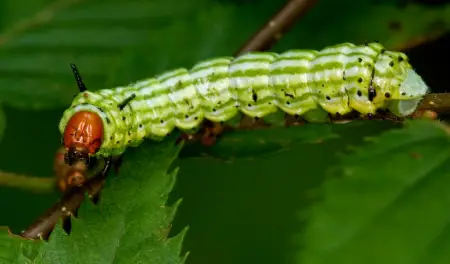
There are five larval stages in the green-striped mapleworm, also known as the Rosy maple moth caterpillar (Dryocampa rubicunda). Initially, it has a pale yellow-green body with subtle green lines, and a dark head. They mostly consume the leaves of beech, oak, and maple trees. As adults, they give up eating. The caterpillars can sting you badly if you come into contact with them, so it’s best to stay away from them.
Snowberry Clearwing Caterpillar (Hemaris diffinis)

The Snowberry Clearwing Caterpillar (Hemaris diffinis) is primarily bright green in appearance, with black spots near its breathing openings. It has a yellow ring behind its head and a black tail spike with a yellow base. Among the plants they consume are dogbanes, buck brush, horse gentian, blue stars, and honeysuckles. It’s interesting to note that these caterpillars are harmless.
Pipevine Swallowtail Caterpillar (Battus philenor)
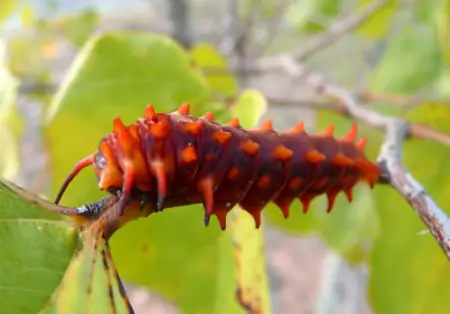
Among other areas where its preferred plant, the pipevine, grows well, the Pipevine Swallowtail Caterpillar (Battus philenor) is typically found in woodlands, open fields, and gardens. Their colors vary from a rich reddish-brown to a brown hue, frequently accompanied by a faint purple tinge at the edges. Their maximum length is two inches.
These caterpillars only consume the leaves of Dutchman’s pipe and birthwort; upon consuming their deadly host plant, they become poisoned.
American Dagger Caterpillar (Acronicta americana)
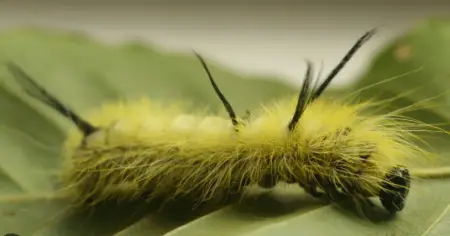
The American Dagger Caterpillar (Acronicta americana) has fuzzy-looking hair that varies in color from yellow to pale green to white. The four little black hair tufts on its first and third abdominal segments, along with an additional one near the end of its tail, serve as distinguishing characteristics.
They are commonly observed in backyards, parks, gardens, and forests. They consume the leaves of many hardwoods, including elm, alder, and ash. Despite their adorable appearance, you shouldn’t touch them because their hairs may burn, irritate, or result in skin rashes.
Fall Webworm Caterpillar (Hyphantria cunea)
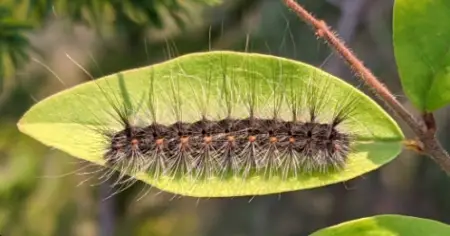
The Autumn Webworm Hyphantria cunea, the common caterpillar of North Carolina, is well known for its preference for eating trees and decorative plants. The mature fall webworm moth is distinguished by its fluffy, vivid white or yellow coloring.
These caterpillars eat on over ninety different types of leaf-shedding trees, including birch, cherry, crabapple, hickory, and walnut. They don’t choose their hosts. Despite their fondness for creating webs around trees, they pose no threat and are harmless. They are usually more of an annoyance than a menace.
Yellow-Striped Oakworm Caterpillar (Anisota peigleri)
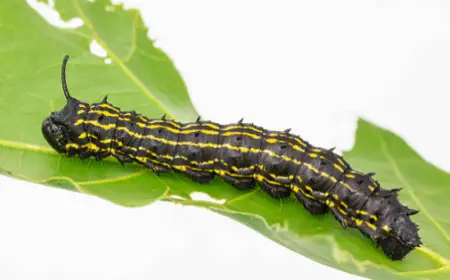
The gorgeous black caterpillar with vivid yellow stripes, known as the Yellow-Striped Oakworm Caterpillar (Anisota peigleri), can reach a maximum size of two inches. Their second thoracic segment is adorned with black extensions that have a row of tiny spikes on them.
During the initial phases, these caterpillars gather in clusters and mostly consume the softer parts of the leaves, often removing them nearly entirely. Despite their seeming prickliness, mature caterpillars are safe and do not provide a risk to humans.
Pearl Crescent Caterpillar (Phyciodes tharos)
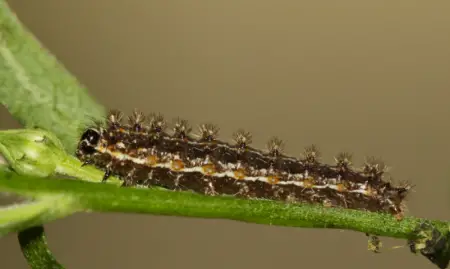
The Pearl Crescent Caterpillar, or Phyciodes tharos, is a wonderful sight that can be found regularly in North Carolina’s open places, including parks, roadsides, and light pine forests. Its sides are softly striped in a creamy tone that varies in hue from deep brown to smoky gray. It features numerous small, branching spikes.
In the early stages, these caterpillars feed in groups, primarily on asters. They are not harmful or hazardous, so don’t be worried if you come across one.
Imperial Moth Caterpillar (Eacles imperialis)
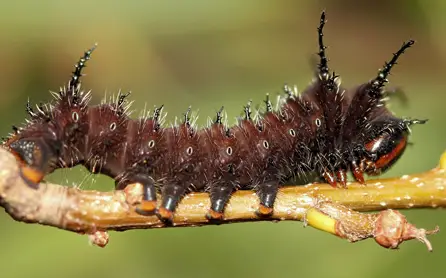
The Imperial Moth Caterpillar (Eacles imperialis) is a remarkable sight, especially when it first appears as tiny, orange creatures that are less than half an inch in size. Their characteristic black spines make them easy to recognize. They grow into big, up to 5-inch-long, green, brown, or occasionally bright orange-patterned caterpillars.
Although they eat a variety of foods, they particularly enjoy eating pine, oak, and maple trees. It’s best to be cautious because the venom in their spiky exoskeleton can sting when handled and cause allergic reactions in some individuals.
Eastern Tent Caterpillar (Malacosoma americanum)
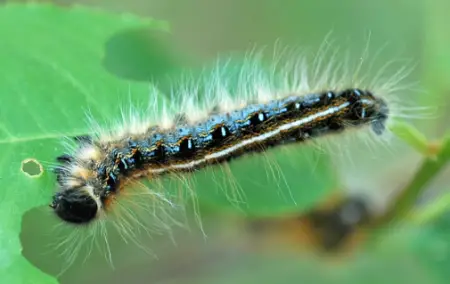
The Eastern Tent Caterpillars (Malacosoma americanum), who are well-known for their gregarious behavior, construct communal nests in their hundreds to share food and warmth. These caterpillars have soft bodies with blue, black, and orange coloring combinations. They have tufts of hair down their sides and a characteristic line running along their back. When they reach full size, they are around two inches long. They typically consume the leaves of apple, cherry, and wild crabapples.
Monarch Caterpillar (Danaus plexippus)
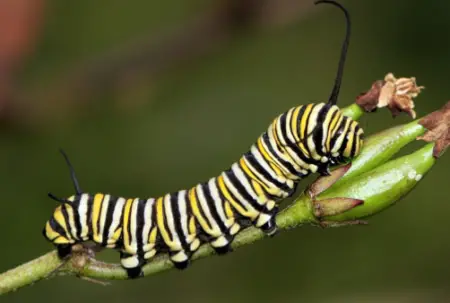
In North Carolina, the Monarch Caterpillar (Danaus plexippus) is a well-known milkweed butterfly with orange, white, and black wings. Its life cycle consists of five stages, each of which results in skin loss. Every stage lasts approximately five days, depending on the temperature and food availability.
The caterpillar appears gray-white to pale green after hatching. On a green background, dark lines with small bumps creating the front tentacles gradually emerge. In the second stage, its design changes to include bands of yellow, black, and white. Its black tentacles are starting to spread, and it has a yellow triangle on top of its head with two yellow bands encircling it.
Silver-Spotted Skipper Caterpillar (Epargyreus clarus)
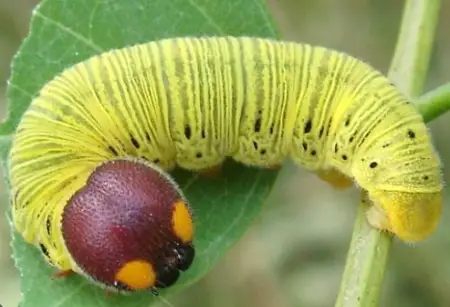
The Silver-spotted Skipper (Epargyreus clarus) is a frequently spotted butterfly found in fields, gardens, and the boundaries of woodlands in North Carolina. Its caterpillar eats leaves from many different kinds of plants, including vines, trees, shrubs, and herbs in the pea family.
These caterpillars live in wetlands and meadows, reaching up to 5 cm in length and an average life span of 2 months. Predators that they must deal with include wasps, birds, spiders, and frogs.
Banded Tussock Moth Caterpillar (Halysidota tessellaris)
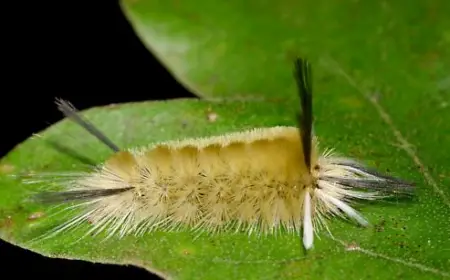
First discovered in 1797, the Pale Tiger Moth (Halysidota tessellaris) is also known as the Banded Tussock Moth. Their bodies are coated in long, tufty hair that might be orange, yellow, or dark gray when they are caterpillars.
They have long hair that might be orange, white, black, or blazing orange on top. When these caterpillars are at rest on leaves, they can grow up to a length of 3.5 cm. During the winter, they pupate in gray cocoons covered in larval hairs.
People Who Read This Also Read:





